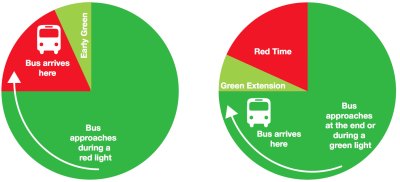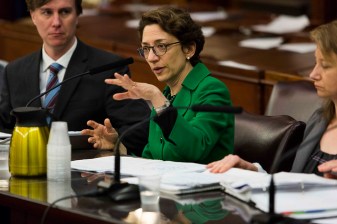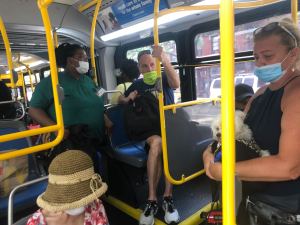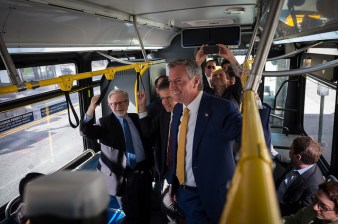EXCLUSIVE: Despite COVID, DOT Really Stepped Up Transit Signal Priority This Year
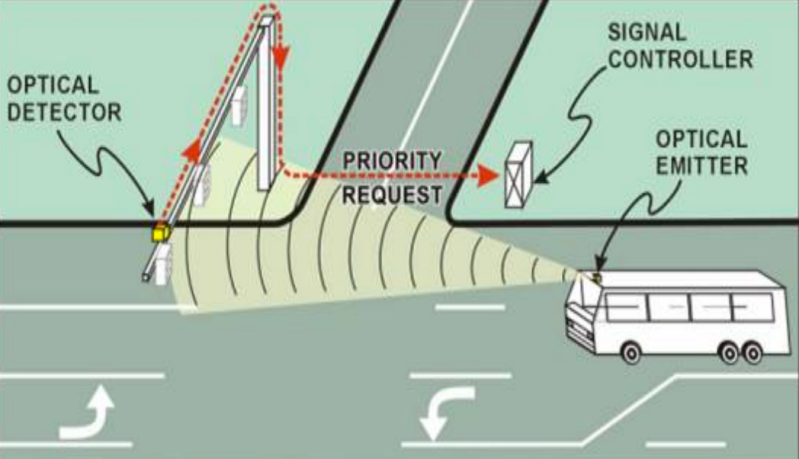
The effort to help buses move faster is … moving faster!
Despite reported delays in the rollout of Transit Signal Priority technology for MTA buses, the Department of Transportation will reveal later today that it has exceeded its goal and installed the technology — which gives or extends green lights for buses — at roughly 1,382 intersections citywide.
In 2017, the city had said it hoped to install TSP at 1,200 intersections — but engineers have quickened the pace at which they conduct their traffic studies and were able to configure 461 intersections during this COVID-fractured year alone.
One of the newly TSP’d corridors is E. 149th Street in the Bronx, where DOT Commissioner Polly Trottenberg is scheduled to highlight the agency’s achievements at a press conference at 11 a.m. Also on hand will be Craig Cipriano, president of the MTA’s bus division.
“This is going to be hugely important for bus speeds,” Cipriano told Streetsblog. “When we do TSP and other treatments like dedicated bus lanes and enforcement cameras, our buses complete their runs up to 20 percent faster.”

The DOT will reveal 14 key bus corridors that have gotten TSP this year:
- Manhattan
- Madison Avenue, serving the uptown M1 and M4
- Fifth Avenue, serving the downtown M1 and M4
- 14th Street, serving the M14A/B SBS
- Ninth Avenue, serving the M11
- West End Avenue, serving the M57
- Seventh Avenue, serving the M2
- Eighth Avenue serving the M20
- Staten Island
- The S74/S84 corridor
- The S44/S94 corridor
- Hylan Boulevard, serving the S79 SBS
- The Bronx
- E. 149th Street, serving the BX19 (bus speeds on this route were some of the slowest in the city, around 3.9-4.3 miles per hour, according to the MTA).
- Queens
- Merrick Boulevard, serving the Q5, X63, Q17, Q3, Q30, Q36, Q4, Q42, Q77, Q84, Q85
- Brooklyn
- 18th Avenue, serving the B8.
The ridership on those 14 corridors, pre-COVID, was 233,934 a day — all of whom will benefit from faster buses. MTA statistics show that average bus speeds increased from 8 percent (on the S62 in Staten Island to 25 percent on the Q5 in Queens, which means buses improved from an average of 5.7 miles per hour to 7.1 miles per hour, which sounds like a little, but does add up over the course of a bus route).
The quicker pace of installing TSP represents a change in approach from 2018, when Trottenberg said the agency would focus on intersections rather than whole corridors. In addition, DOT engineers were initially unable to move quickly because studying the traffic impact of TSP on a given intersection required massive amounts of computer time to multiple computer simulations to devise the ideal amount of time to shave off of cross street traffic at a given intersection.
But that digital logjam was broken, according to DOT Deputy Commissioner Josh Benson, when engineers started using the MTA’s live “bus time” feed. By using the live telemetry from buses as they journeyed on their routes, engineers could very quickly see, in real time, what happened if they flipped a few switches (or, more accurately, moved around a bunch of ones and zeroes on their screens) to change light timing.
“It took a couple of years to develop this new system and we are reaping the fruits of it this year,” Benson said. “The industry standard when we started doing TSP in 2006 was to build elaborate computer simulation models, but the computing took hours and days before you get results. And then you’d make a small tweak in the model, and it would take hours or days to get the new result.
“Now we can see in a day if we need to hold the green for six seconds or 10 seconds,” Benson added. “You can see how a bus is moving, make a change, and see if it worked.”
Advocates have complained at the delays to wider installation of TSP, and Cipriano understood how it looked from their side.
“With TSP, it’s easy for me to say, ‘Let’s have TSP at every intersection tomorrow,’ but a road has many users: motorists, bicyclists, pedestrians and the bus riders. It has to work for everyone,” he said.
Benson claimed that DOT’s Transit Signal Priority engineering is all about making sure pedestrians don’t get screwed. With TSP installed, buses communicate their location to traffic signals, which then hold a green light longer if a bus is in range or shortens the time a bus will spend at a red light if it is already stopped.
“If you only cared about buses, you could prioritize the bus, and TSP would be very easy,” Benson said. “But that’s too simple a way to look at it. Pedestrians need time to cross a street and we can’t cut the minimum time we give pedestrians — which is the time from when the ‘Don’t walk’ hand starts flashing. If the signal cycle is in that flashing hand period, the bus can’t receive the TSP benefit.”
With the live bus time data, traffic engineers can see patterns on any given line — such as bus stops that are located just before traffic signals. At such intersections, bus passengers wouldn’t benefit from an early or extended green light because the bus has to stop to pick up new passengers or drop off departing ones.
“Improving bus speeds is collaborative,” Cipriano said.
When pressed by Streetsblog, Cipriano admitted that his ideal collaboration with DOT would be to get the agency to ban cars from almost every roadway so buses can move freely.
“I am the biggest advocate for the bus system and bus customers,” he said, “so I would want the whole city to be a busway. We want buses to have more priority, ahead of cars, and everyone. But we live in a city with many modes of transportation.”
The city is currently building 20 miles of car-free busways and dedicated bus lanes this year, which is not nearly as much as the MTA wanted, but it is more than the city has ever done in a single year.
“My boss said she wanted 60 miles,” Cipriano said, “but this is a good start.”
Friday’s announcement of the TSP corridors will also include some Citi Bike news (though Streetsblog readers will have to wait until the press conference to find out what it is) and a reminder that bus lane enforcement cameras will go into effect on E. 149th Street on Friday, starting with warnings for the next two months before the cameras start spitting out tickets, which start at $50 and can escalate to $250 for a fifth violation in a one-year period.
